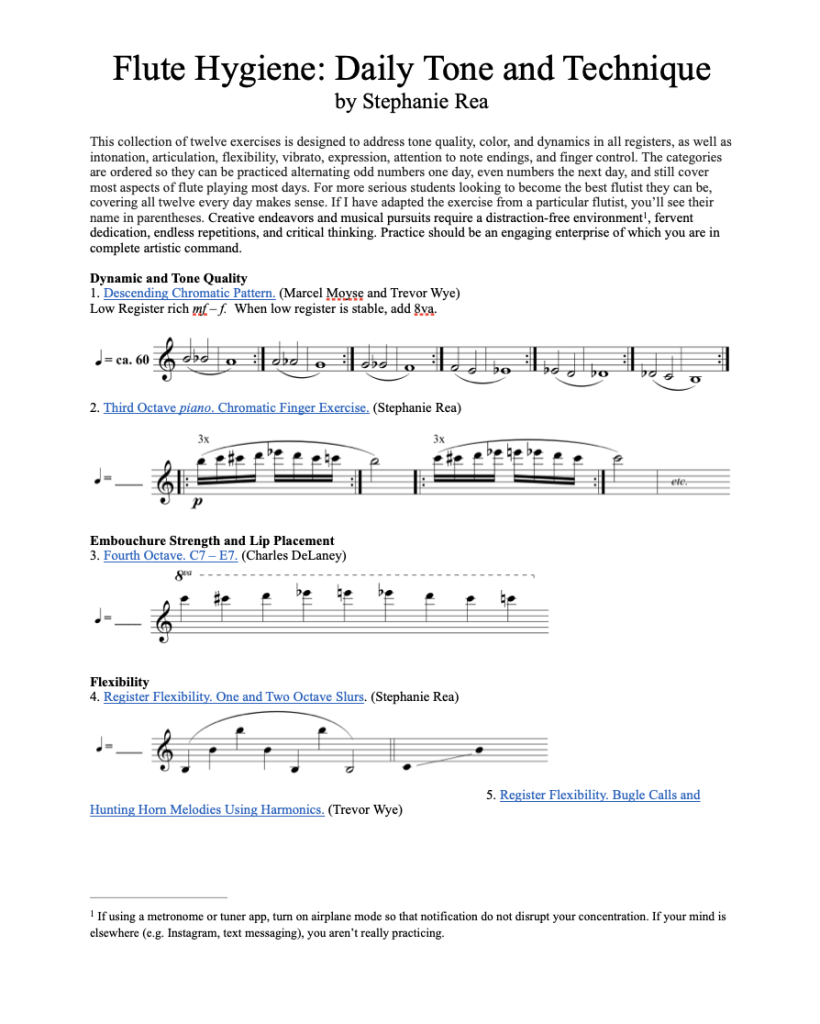Stephanie Rea
From January through May of this year, I was fortunate to have a one-semester sabbatical from my normal teaching as Professor of Music at Murray State University. It is not lost on me that in today’s world, holding a tenured teaching post in classical music, not to mention the benefits that come along with it, is a fairly rarefied and rather lucky thing to have. And to be granted a sabbatical from this type of work in order to write a book about the very thing that I do, well, it doesn’t get much better. After twenty-three years in the same job, it was a welcome turn from my regular routine, a refreshing change of pace that I am thankful to have had.
Almost every hour of my normal teaching day brings a new task: teaching a flute lesson, attending a meeting, preparing for a class, teaching a class, teaching another flute lesson, practicing on my own, rehearsing, grading assignments, advising a student. Never a dull moment. And the unstructured nature of a sabbatical is an about face from this day-in-day-out semesterly existence. It gave me the opportunity to be almost completely autonomous and uninterrupted in my day-to-day work as I set off on the quest of writing a book about flute playing and how I teach it.
To be clear, I’m a performer and professor, not a writer, but writing does make its way into my workload in many ways: emails, lesson plans, lectures, assignments, evaluation of student work, tenure reports, committee work, and more. But writing a book is a different animal. It requires a more expansive look at a topic. It takes logic and analysis to break that topic into smaller ones, many of which overlap with each other so much that it makes any book-like unidirectional treatment of these topics feel rather insufficient. At times, the topics I was writing about felt more like a twenty-five circled Venn diagram than any linear outline. Would creating a Prezi or a website been a better format for the information I was trying to present? Maybe. So, how to approach and organize these endlessly interrelated topics in book form? There seemed to be limitless ways to do this, none of them necessarily clearly better than another.
The beginning of the sabbatical was a little troublesome in this regard. The ordering and reordering of topics was at times a fun and exciting challenge. Other times, it seemed a discouraging exercise in futility. It could be a daily existential crisis! How much did this order matter? How much did it matter to me? These are some of the questions I wrestled with. And though I had a basic outline, I wasn’t sure how long the book would or should be. Seventy-five pages? A hundred? More? I wanted a project that I could finish. Could I really finish that many pages in four months? Initially, I couldn’t even bring myself to call it a book when I first began writing. I started calling it a booklet and then a handbook. “What are you doing on your sabbatical?” people would ask. “I’m writing a book….well, a booklet.”
After the initial weeks, I settled into the process, and the creative challenge of writing became a lot of fun. Playing with words is something I really enjoy both in written and spoken form, and to be able to devote significant amounts of time to that was exciting, a truly worthy difficulty and an enjoyable one. I found myself using a dictionary and a thesaurus every single day, even looking up words whose meanings I know, but looking them up anyway because I wanted to know the precise definition in order to maximize a particular word’s impact. This is not something I typically have much time for during my regular teaching when nearly every hour of the day is spoken for. I was able to call on lesser used parts of my brain for the kind of work that I don’t normally get to delve into so deeply. Bliss!
While much of the sabbatical was devoted to writing the narrative parts of the book (it also contains charts, graphs, photos, lists), the daily exercises I use with my students were ones I’d been using for a long time. I’m excited to include them here for you. They themselves have also been tweaked and reordered many times through the years in my search for the ever-elusive perfect pedagogical approach. Each exercise has a short video tutorial that helps explain in a little more detail just how to work on them and what there might be to gain from each one. In no way am I reinventing the wheel here. These exercises are the standard kinds of things that most flutists do on a regular basis, but a fresh or unfamiliar take on a classic certainly has value. As I say below, I have ordered them in a way that they can be practiced alternating odds one day, evens the next, and still allow for most aspects of flute playing to be covered, but those serious about practicing will enjoy all twelve in a daily routine.
Below is a two-page version of these exercises that I include in the Appendices of Flute Hygiene: A Guide for Developing and Maintaining the Habits That Lead to Better Flute Playing. In Chapter Four of my book, I expound more on each exercise, so if you’re interested in knowing more than what I provide in the video links, you can download a free pdf of the full book here. I wish you well in your flute playing and everything else. Happy practicing!
Click on image to view a .pdf of “Flute Hygiene: Daily Tone and Technique by Stephanie Rea”


